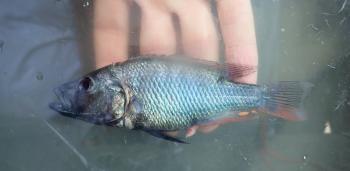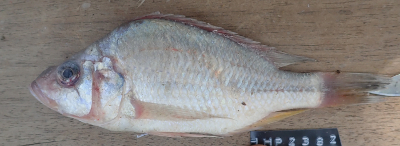Ten New Species of Predatory Fish from Lake Edward
A team of Belgian researchers has described ten new species of small predatory fish from Lake Edward. Scientists have long suspected that this lake between the DR Congo and Uganda is home to exceptional fish diversity.

Dominant male of the news species Haplochromis glaucus.
The East African Great Lakes are inhabited by some 2,000 species of cichlids, perch-like fish with spectacular colours and often complex behaviour. They are popular with aquarium enthusiasts, but also with scientists because they are a model group for research on evolution. In fact, the species emerged faster than within any other group of vertebrates.
Worldwide, one in twenty fish species is a cichlid. One of the reasons the cichlid family is so diverse is because species developed different lifestyles and food preferences. For example, some cichlids specialize in eating algae, others live on insects, plankton, snails, scales, or other fish.
From 2 to 12 piscivorous fish
Lake Edward lies on the border between the Virunga National Park in the DR Congo and the Queen Elizabeth National Park in Uganda. 'We had long suspected that the fish in this lake are enormously species-rich,' says Jos Snoeks (Royal Museum for Central Africa and KU Leuven), who led the research. 'But little field work was done, partly because the political situation in the Congolese part of the region was unstable for a long time. We now had the opportunity to study the lake's cichlids in a research project on the ecology of Lake Edward.'
For his doctorate, Snoeks' colleague Nathan Vranken worked on the description and classification of the cichlids of Lake Edward. He first did so based on museum collections. 'During the 1930s and 1950s, specimens were already being collected, but they were barely studied. I investigated thousands of specimens in the collections of the Royal Museum for Central Africa and the Royal Belgian Institute of Natural Sciences.'
'These old specimens from museums did however lose their original colours,' Vranken explains. 'Colour patterns are important in cichlids, especially in males: often this is the feature that allows us to distinguish species from each other. So, we also had to collect fish on site to properly document their colours.'
Especially the group of piscivorous cichlids turned out to be very species rich. 'Before I started this study, only two species of fish-eating cichlids were known from Lake Edward, of which some scientists even thought it was only one. By looking at the colours of live males, we were able to distinguish as many as 12 groups. We also noted small but consistent differences in body structures and dentition. That confirmed our hypothesis that those 12 groups were indeed distinct species.'
'There was a clear difference between species with many small teeth, and species with a smaller number of larger teeth. I suspect that they have different hunting strategies,' says Vranken.

DNA-research
Why conduct a time-consuming study on old material when you can just read the DNA? 'The emergence of these species is so recent in evolution that not enough genetic differences have accumulated yet,' says Maarten Van Steenberge (Royal Belgian Institute of Natural Sciences). ‘So, we can't use the standard genetic methods, where we only look at specific pieces of DNA to distinguish species. We are now planning an additional part to this study in which we want to determine and investigate the complete genome of these and all other Lake Edward species. That way, we will gain insight into how the species differ genetically and which genes are important for species formation.'
By determining the complete genome of the fish, the researchers may unravel even more mysteries. 'We estimate that there are about 80 species of cichlids in Lake Edward, of which at least 12 are predatory fish,' says Vranken. 'Those predatory fishes are more diverse than many other groups in both morphology and colour patterns. Could predatory fish have evolved earlier than those other groups, and thus emerged earlier in the evolution? We hope that when we have the complete genetic information of all species, we will be able to answer these and many other questions.’
This study was published in the European Journal of Taxonomy. It is the result of an international collaboration of researchers from the KU Leuven, the Royal Museum for Central Africa in Tervuren, the Royal Belgian Institute of Natural Sciences, and the National Fisheries Resources Research Institute in Uganda (NaFIRRI). The study was funded by FWO, the Belgian Science Policy Office (BELSPO), and the King Leopold III Fund for Nature Research.


